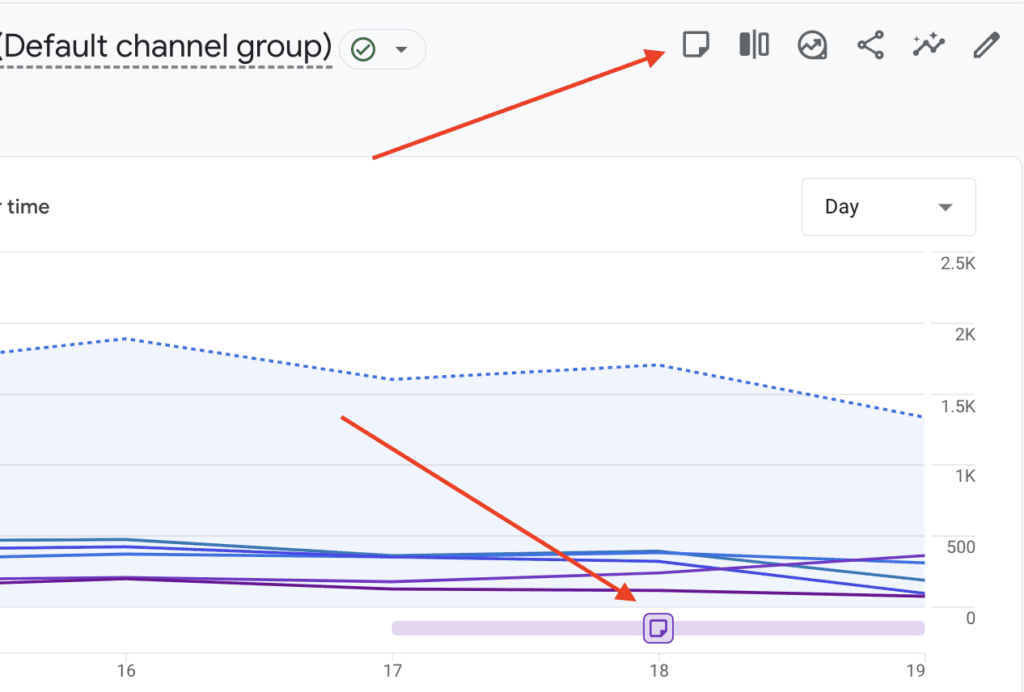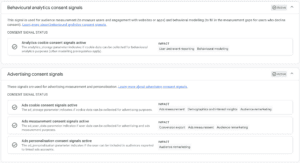Analytics
Check out all the latest updates to Google Analytics on our handy update page here
Conversational AI Agent ‘Analytics Advisor’ Launches in GA4
Analytics Advisor is a Gemini-powered conversational assistant aimed at speeding up analysis and helping users act on insights directly inside a specific Analytics property. It works in a way to assist users in getting the answers, visualisations, and report links that they need faster.
Analytics Advisor can help with a range of query types, including performance snapshots, trends for specified metrics/dimensions/events, and questions about your data/configuration.
Read more about Analytics Advisor in GA4Google adds display dynamic remarketing in Google Analytics
Google has launched an update which allows Google Ads customers to serve dynamic remarketing ads based on data from Google Analytics. Google said, “This feature allows advertisers to transfer dynamic attributes, such as product IDs or price values, directly to Google Ads for dynamic remarketing campaigns. This eliminates the need to manually define and map parameters, simplifying the setup process and enabling more dynamic and relevant ad experiences.”
If your Google Ads and Google Analytics accounts are linked and you have data sharing enabled, Google Analytics will automatically share the dynamic data with Google Ads, enabling businesses to use it for better targeted remarketing efforts.
Learn more about dynamic remarketing data in GA4Google adds custom event parameters to Google Ads tags in Google Tag Manager
Google has launched an update to Google Ads tags in Google Tag Manager, which allows users to send custom event parameters with Google Ads conversions.
The new parameters will populate automatically in Google Ads shortly after you add them to your conversion tracking tag. For that data to be recorded, you’ll need to “activate” those parameters from within Google Ads. After you activate the custom variables in your account, the data will start recording and be available in reports a couple of hours after.
This brings Google Ads tracking more in line with the GA4 standard and opens up the possibility of more comprehensive reporting within the Google Ads platform. You’ll be able to split your conversion reports by the parameters you send. For example, a clothing retailer might want to send the colour of a particular jumper, or a restaurant might want to send a booking date.
Read more about custom event parameters in Google AdsGA4 improves availability of item-scoped dimensions and metrics
GA4 has launched an improvement to ecommerce data availability and usability for item-scoped dimensions.
Improvements include:
- E-commerce dimensions (default and custom) are now available in Reporting for use as secondary dimensions, filters, and comparisons.
- E-commerce metrics (default and custom) are now available in Reporting customisation.
The update will allow users to dive into the granularity of e-commerce events for items and create more comprehensive reports to support internal needs.
Read more about available e-commerce dimensionsGoogle launches official readAnalyticsStorage API
Following issues with broken tracking after recently updating its cookie formats, Google has launched an official readAnalyticsStorage API, which can be used in Google Tag Manager as an official and more reliable way to retrieve client_id and session_id. Previously, people used unreliable, reverse-engineered methods to pull both IDs, as they were useful for offline conversion tracking through CRMs, for example.
The launch will allow users to pull the data officially and not be impacted by format changes in the future. GTM templates are already available on GitHub and are expected to be available in the community template area of Google Tag Manager soon.
Find out moreGA4 adds new reports for offline lead tracking
GA4 has introduced two new reports to help users better understand offline conversions.
The first new report, lead acquisition, focuses on generate_lead, and new events working_lead, qualify_lead, and close_convert_lead.
The second new report, lead disqualification and loss, focuses on new events, disqualify_lead and close_unconvert_lead.
These new events are designed to work primarily with offline conversion tracking by having your CRM send lead updates once a user has converted. The additional context will help you better analyse the journey of leads which convert and which don’t.
You’ll need to utilise the generate_lead event, a standard event in GA4, to get the most out of this. If you don’t use it and instead use a different naming convention for your forms or lead tracking, you should update those first.
Learn more
GA4 expands data sources for cost imports
Google has announced an update for GA4, which enables users to import external cost data from more sources. Additional sources for data import will make it easier to bring data in from existing sources with minimal effort once the initial setup has been completed.
You can now import cost data for additional reporting from the following sources. Once imported, you can analyse the data in the acquisition or planning reports right away.
- Google Sheets
- Amazon Redshift
- Amazon S3
- BigQuery
- Google Cloud Storage
- HTTPS
- MySQL
- PostgreSQL
- Snowflake
Custom dimensions and metrics now sync between properties and sub-properties
Google has announced a GA4 update for GA4 360 customers to help maintain consistent measurement between the main GA4 property and any sub-properties. Custom dimensions and metrics can now be synced between them. The feature is available for both newly created and existing sub-properties that do not have any custom dimensions or metrics set up. Google states that this will minimise the impact on current configurations.
Learn more about property syncing in GA4Google Marketing Live: GA4 and performance monitoring
Google has just finished its ‘Google Marketing Live,’ and here is what we learned about GA4 and campaign measurements.
Cross-channel insights in GA4 are getting an upgrade, making it easier to track performance across platforms.
The minimum spend for incrementality testing will be reduced from $100K to $5k
A new Bayesian-based testing model means you can run tests in as little as 7 days.
Data Manager will consolidate first-party data from BigQuery, HubSpot, Salesforce, and Shopify, and a new API will facilitate smoother integrations.
They have introduced “Google Analytics experts” for in-depth analysis and strategic advice, and a “Marketing Advisor”, an AI agency assistant that offers step-by-step guidance.
And the big one, a unified view of impressions across both Google platforms and third-party data. This allows you to bridge the gap when understanding the full funnel.
Find out moreGoogle rebrands first-party mode to Google Tag Gateway
Google has launched an update to the first-party mode for tag management – Google Tag Gateway, and partnered with Cloudflare for the rollout and making it available on all plans, not just the paid ones.
Google Tag Gateway allows websites to serve Google Tags from their own domain rather than Google’s, and this can help avoid problems with browsers and ad-blockers, particularly for those users who have consented to cookies.
Early users are seeing around 11% uplift in data, and the setup is minimal. If your website is running through Cloudflare and you’re using Google Tags, it’s a no-brainer to get the Tag Gateway set up and help restore some of the data being lost in GA4 and Ads.
Read more on the Cloudflare blogGoogle Analytics launches updates to improve ‘Enhanced data completeness’
Ginny Marvin, Ads Product Liaison at Google, announced on LinkedIn that Google Analytics is getting some updates to help ‘enhance data completeness’.
GA4 is rolling out aggregate identifiers to help improve attribution accuracy for Google Ads when GCLID isn’t available. Where GCLID or aggregate identifiers are not available, the fallback will be manual tagging through UTMS. According to Google, this will prevent Google Ads traffic from being incorrectly attributed to the Organic Channel.
Also mentioned are new reporting features that will highlight when the data received by GA4 doesn’t have data for the Source & Medium traffic dimensions. If your reports have a notification which says “data is not available”, this will typically mean that you can’t do much to improve it. If you see “not set”, this indicates that steps could be taken to improve the data coming into GA4, and you’ll be presented with some tooltips to help.
The final updates were a new Data Quality Indicator at the top of reports that will help users resolve potential issues with links that could be causing attribution errors, and System Generated Annotations, which will be added to highlight changes that could impact your data measurement.
Read more about these updates from GoogleGA4 launches AI powered ‘Generated insights’ in detail reports
Google has launched ‘Generated insights’ into GA4 detail reports to help users understand changes in the presented data. For example, if the purchase event spiked on a given day, Google will use AI to try to connect the dots and present more insights in plain language to explain why that has happened. We’re expecting to see AI being baked into the GA4 platform as we progress throughout 2025 and this is a good start for users.
Image credit: Google
Learn more about generated insightsGA4 launches annotations
Annotations have finally landed in GA4 and allow users to add them for time periods and have them displayed in graphs across the platform. Annotations were a very popular feature of Universal Analytics and have been much requested in GA4 since it launched.

Annotations are a great way of applying context to your GA4 data. For example, they could be used to note offline advertising campaigns, tracking changes, website/page launches, technical SEO changes, PPC campaign launches, Social Media campaign launches, or anything useful to your business to remember when reviewing website performance data in GA4.
Google Tag Manager launches changes to the way Google Ads tags load
Google has announced that from 10th April 2025, Google Tag Manager containers with Google Ads or Floodlight tags will automatically load a Google Tag first. This will help improve campaign performance measurement and Google has said the change will have no negative impact. Most users will see an uptick in measurement.
The change will also facilitate easier access to features such as cross-domain measurement, enhanced conversions, and auto-event tracking from within tag settings.
A core change will be the automatic enabling of “User Provided Data” collection across your events if you have accepted the Customer Data Terms of Service. It’s important to remember to check whether this aligns with your consent policy and any applicable local privacy laws such as GDPR.
Read more about the upcoming changes to Google Tag Manager and Ad TagsGA4 launches improvements to reports & not set data notifications
Google has rolled out some useful features for GA4 that will help users obtain more context at a glance in reports and better understand why (not set) traffic might be appearing in acquisition reports.
Percentage values in Google Analytics report tables
In detailed reports and Ad modules, Google has added a percentage column so users can easily understand the proportion of that dimension against the primary metrics the report is displaying. For example, what percentage of traffic is coming from each default channel group.
Missing session start notification
Where a report has a high volume of missing session_start events, GA4 will flag this and direct the user to articles on how best to resolve this issue.
High not set rate notification
If a detail report contains a high amount of (not set) traffic, Google will display a notification with more information about the issue and directions on how to fix it. An example flag would be “This report contains a (not set) value because no data was received.”
GA4 reduces required parameters needed for cost import data
Google has launched an update for GA4, reducing the required fields needed to import external cost data into the platform.
Moving forward you will only need the following fields:
- Source
- Medium
- Date
Historically, you also needed to import campaign_name and campaign_id, and where this data is available, Google recommends importing them as key fields as they will assist in more granular reporting from within GA4. When cost data is imported without them, GA4 will report in aggregate for those dimensions if requested.
Learn more about importing third-party cost data into GA4Google opens up media mix modelling with Meridian Launch
This week, Google launched its open-source media mix model tool, Meridian, to everyone.
Meridian uses advanced modelling to help optimise your ad budget insights and make spending more efficient. The ability to plug in Google Ads data and other data sources using Bayesian causal inference methods will help marketers better understand how their campaigns impact the performance of all channels.
Historically, media mix models (MMMs) have often focused primarily on offline advertising and missed the curve on more advanced online strategies. Meridian has been designed to fix that issue and offer a more comprehensive way to measure marketing success in the long term. It combines online and offline data, such as how a TV ad has or could impact your online campaigns.
MMMs also help marketers move beyond traditional conversion metrics in reporting to measuring the impact campaigns can have on an overall business.
One of the key features of Meridian is being open source, and that means marketers can take the code as it is and, if needed, customise it to better meet their individual needs. For example, if you’re working on a client which you know has seasonal trends which differ from the average market ups and downs, you can bring that data into the mix to increase the accuracy of the model. Being built by Google also means it has native connections to all of the data from its platforms that you would expect.
MMMs are not new, but this is a significant step towards the future of campaign measurement and also a vital one when you consider the impact privacy laws and cookie restrictions have had on traditional analytics tools over the past few years.
We spoke to the Founder and CEO of the marketing analytics agency ELIYA, Saeed Omidi about his thoughts on Google’s new update:

Expert opinion
Saeed Omidi, Founder and CEO of ELIYA
We also spoke to Himanshu Sharma, Founder of Optimize Smart:

Expert opinion
Himanshu Sharma, Founder of Optimize Smart
GA4 adds ability to copy custom reports across properties
GA4 now has a feature where users can copy custom detail reports or exploration reports from one property to another that you have at least edit access to. This will save users time when they need to view the same reports across different properties for different websites and help avoid configuration differences.
Learn more about copying customer GA4 reports across propertiesGA4 adds a Consent Settings Hub
Google has added a consent settings hub within GA4 which gives users a more granular overview of their current consent status and setup for both analytics and ad-related cookies. It allows a better understanding of what each consent status means and what impact if could have on your reporting.

Automated first-party mode for Google Tags launches in closed-beta on Cloudflare
In a push to promote website owners to upgrade to first-party tracking setups, which Google recommends as the most durable tagging configuration as it can help improve measurement signals, a closed beta has been launched, allowing automated setup for the solution within Cloudflare.
As testing continues, we can expect this feature to launch fully in the coming months. The automated solution will remove many roadblocks website owners run into when setting up first-party tagging. We expect this in the future to become the new standard for websites that don’t necessarily need a full server-side tracking setup.
We spoke to Dan Truman, Managing Director of Duga Digital about the update. Here are his thoughts:

Expert opinion
Dan Truman, Managing Director of Duga Digital
